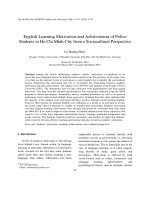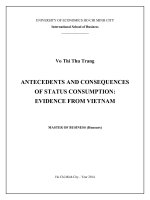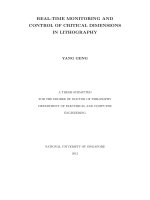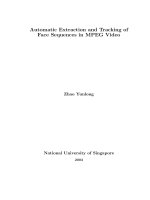Antecedents and consequences of role stress in hospitality industry
Bạn đang xem bản rút gọn của tài liệu. Xem và tải ngay bản đầy đủ của tài liệu tại đây (332.19 KB, 104 trang )
ANTECEDENTS AND CONSEQUENCES OF ROLE STRESS IN
HOSPITALITY INDUSTRY
TU NING
( B. Management, Zhejiang University )
A THESIS SUBMITTED
FOR THE DEGREE OF MASTER OF SCIENCE (MANAGEMENT)
DEPARTMENT OF MANAGEMENT AND ORGANIZATION
NATIONAL UNIVERSITY OF SINGAPORE
2004
Acknowledgements
The completion of my Master thesis represents the end of my academic training in
National University of Singapore. I want to take this opportunity to give my gratitude
to a select few for their time, talent, assistance and encouragement in the past three
years.
First, I am greatly indebted to Professor N. Rao, Kowtha, my advisor, who was
always very patient and kind to give me suggestions and ideas in my work. He was
really helpful in the whole process of this thesis. Not only he is a good advisor in my
MSc study, he also cares about my life in Singapore. I really appreciate it.
I also want to extend my gratitude to the senior managers and rank & file employees
of several Singapore hotels. Without their co-operation and help, the data collection
process of this thesis could not have been completed.
Finally, I want to give my deepest appreciation to my parents. Mom and dad always
believe in my abilities and give me encouragement all the time. They have shared my
ups and downs during my MSc program. This work is dedicated to them.
I
Table of Contents
ACKNOWLEDGEMENTS ............................................................................................. I
TABLE OF CONTENTS ................................................................................................ II
SUMMARY ....................................................................................................................III
LIST OF TABLES ......................................................................................................... IV
LIST OF FIGURES ·········································································································V
CHAPTER 1: INTRODUCTION.....................................................................................1
CHAPTER 2: LITERACTURE REVIEW AND STATEMENT OF
HYPOTHESIS....................................................................................................................4
Rose Stress ...................................................................................................................6
Antecedents of Role Stress .........................................................................................8
Individual Factors ....................................................................................................8
Self-efficacy .........................................................................................................8
Job Factors ...............................................................................................................9
Task Autonomy ..................................................................................................10
Task Uncertainty ...............................................................................................11
Interaction of Predictor Variables ..........................................................................13
Task Autonomy and Task Uncertainty ..............................................................13
Task Autonomy and Self-efficacy ......................................................................14
Task Uncertainty and Self-efficacy ...................................................................16
Consequences of Role Stress ....................................................................................17
Job Satisfaction ......................................................................................................18
Intention to Quit .....................................................................................................19
Antecedents and Consequences ...............................................................................20
Self-efficacy and Job Satisfaction ..........................................................................21
Self-efficacy and Intention to Quit ........................................................................22
Task Autonomy and Job Satisfaction ....................................................................23
Task Autonomy and Intention to Quit ...................................................................25
Task Uncertainty and Job Satisfaction ...................................................................26
Task Uncertainty and Intention to Quit .................................................................27
Summary ....................................................................................................................28
Research Model and Hypotheses .............................................................................29
Antecedent Variables .............................................................................................30
Moderator Effects ..................................................................................................31
Mediation Effects ...................................................................................................34
CHAPTER 3: RESEARCH METHODOLOGY .........................................................39
Method and Data Collection ....................................................................................39
Measures ....................................................................................................................41
Independent Variables ...........................................................................................42
Mediators ...............................................................................................................43
Dependent Variables ..............................................................................................43
Control Variables ...................................................................................................44
II
CHAPTER 4: DATA ANALYSIS AND RESULTS ....................................................46
Antecedents of Role Stress .......................................................................................51
Consequences of Role Stress ....................................................................................57
Summary of Results ..................................................................................................63
CHAPTER 5: DISCUSSION AND IMPLICATION ···················································65
REFERENCES ............................................................................................................…71
APPENDIX A
APPENDIX B
APPENDIX C
III
Summary
Extensive research in marketing and organization behavior area has been conducted
on role stress in several kinds of service organizations. But the hospitality industry, a
key sector in the service economy, has not received much attention. Even among the
limited number of studies on hospitality industry, few have tried to examine the
determinants of role stress by considering job and individual personality factors at the
same time. This study thus tries to fill up the gap and proposes a model by combining
self-efficacy, job uncertainty and job autonomy as predictors of role stress. Results
support the hypotheses that these factors have great impact on employees’ stress level.
At the same time, these predictor variables are able to influence employees’
satisfaction and quit intention level due to the mediation of role conflict and role
ambiguity. Implications for the human resource management in the hospitality
industry are explored. The suggestions for future research are also displayed.
IV
List of Tables
TABLE 1: T-test Results for the Two Versions of Questionnaires ............................46
TABLE 2: Factor Analysis Results for Each Construct...............................................47
TABLE 3: Means, Standard Deviations, and Correlations ........................................50
TABLE 4: Results of Hierarchical Regression for Role Conflict ...............................52
TABLE 5: Results of Hierarchical Regression for Role Ambiguity............................53
TABLE 6: Mediating Effect of RC and RA between IVs and JS................................58
TABLE 7: Mediating Effect of RC and RA between IVs and IQ ...............................61
TABLE 8: Summary of Results .....................................................................................63
V
List of Figures
FIGURE 1: Research Model ······························································································29
FIGURE 2: Interaction Plot between TU and RC ···························································56
V
Chapter 1
Introduction
Chapter 1
INTRODUCTION
Role stress is a widely researched topic in organizational behavior. Several studies
over the years investigated the effects of role stress on behavioral and organizational
outcomes such as job satisfaction, organizational commitment and turnover (Jackson
& Schuler, 1985). Two role-related stress constructs which have been the main
concern of research are role conflict and role ambiguity.
Several studies (Kahn and Quinn, 1970; Jackson and Schuler, 1985; Pierce, Gardner,
Dunhan & Cummings, 1993) have investigated the predictors and outcomes of these
two stress variables. The studies so far indicate that job characteristics and individual
personality variables are the potential antecedents of role stress. Some of the
antecedents are task autonomy, task uncertainty and self-efficacy. Results have shown
that while task autonomy tends to lower people’s role stress, task variety and
uncertainty tend to increase people’s stress (Jackson and Schuler, 1985). Empirical
evidence also support that both role ambiguity and role conflict are linked with
greater job satisfaction and reduced quit intention (Fisher & Gitelson, 1983; Jackson
and Schuler, 1985).
However, not all the studies yielded consistent results. For instance, Van den Berg
and Feij (2003) were unable to find the expected influence of task autonomy and skill
variety on stress, neither can they find the expected relationship between work selfefficacy and work stress. Agarwal & Ramaswami (1993) found an insignificant
correlation between task autonomy and role conflict. Zellars, Hochwarter, Perrewe,
1
Chapter 1
Introduction
Miles and Kiewitz (2001) also reported that individual self-efficacy hardly had an
impact on role conflict. Chebat & Kollias (2000) provided the results that selfefficacy is unable to influence role stress dimensions. Godaro (2001) failed to report a
significant influence of team autonomy on stress. Role ambiguity fails to link with
people’s quit intention and job satisfaction in Singh’s study (1998) either.
The conflicting results of pervious studies indicate that more research is needed to
clarify the theoretical and empirical issues. Furthermore, none of the previous study
has tried to include the task autonomy, task uncertainty and self-efficacy as
antecedent variables in one single study. The three antecedent variables tested alone
may or may not show significant results in previous studies. By including them
together, however, may yield some new insights about interaction and mediation
effects on role stress. Therefore, this study attempts to advance previous stress
research by examining the antecedents and consequences of role stress. Specifically,
task autonomy, task uncertainty and self-efficacy are included as antecedents of two
role stress variables; while job satisfaction and quit intention are treated as
consequences of role stress.
There is another concern in previous stress research. Few of researchers have tried to
examine the mediating role of role stress between the above antecedent and outcome
variables. More often, they examined the relationships between antecedent variables
and role stress on the one hand, and the relationships between role stress and outcome
variables on the other hand (Ruyter, Wetzels and Feinberg, 2001). With the consistent
strong relationship between the antecedent and outcome variables included in this
study, however, it is reasonable to infer that role stress could be mediator here.
2
Chapter 1
Introduction
In order to meet the above two objectives, this study is conducted in service industry.
Certain level of role stress in the form of role conflict and role ambiguity is common
among service employees because they have to interact with customers and other
stakeholders at the boundaries of organization. In this case, service employees are in a
better position to understand the current research topic and able to provide the
relevant information.
In particular, this study collected the data from Singapore hotel industry. Hotel
industry has almost been ignored (Zohar, 1994) in role stress studies though it plays a
large part in service industry. It is very demanding because of its extremely high
turnover rate and unusual working hours. Hotel employees frequently report low level
of job satisfaction and a high intention to quit their jobs (Bozeman et al, 2001). The
results of this study should be able to provide some managerial implications for hotel
managers.
In sum, the main purpose of this study is to examine the relationship between three
job characteristics and individual antecedents and two outcome variables of role stress.
The mediating role of two stress variables has also been tested. Based on the data
from hotel industry, this study makes a contribution in a theoretical understanding of
role stress in the service industry.
The next chapter critically reviews and synthesizes the literature. Based on this review,
I present a model that links the antecedents and consequences of role stress and then
derive several hypotheses. These hypotheses were tested in the Singapore context. In
chapter 3, the research design and methodology used in this study will be discussed.
3
Chapter 1
Introduction
4
Chapter 2
Literature Review and Statement of Hypothesis
Chapter 2
LITERATURE REVIEW AND STATEMENT OF HYPOTHESIS
The increasing interest in service organizations reflects their economic importance.
However, traditional ways for managing manufacturing organizations are less viable
in service organizations because these two kinds of organizations are largely different
in terms of the operating system (Lovelock, 1983; Gummesson, 1994). Customers do
not directly influence the daily operation of manufacturing organizations while they
would have a great impact on service organizations. There is a close relationship
between customer’s experience of service quality and employees’ job satisfaction
level within their organizations. In this regard, Schneider and Bowen (1985) pointed
out that human resource management is crucial for service organizations’ efficiency
and success although managing service employees is not an easy task.
With more chances to interact with customers face to face, many service employees
are likely to assume boundary-spanning roles which tend to give rise to role stress,
such as role ambiguity and role conflict (Lysonski, 1985). When stress exceeds a
certain level, employees are inclined to seek ways to alleviate their experienced stress
or they have to escape from the uncomfortable situation and this is not a desirable
outcome for the organization.
People, however, do not respond similarly when they are faced with the same level of
job stress. Some people are better prepared to cope with stress than others, so stress
might not be that harmful to them. Besides individual factor, stress might also be
affected by employees’ job characteristics and working environment. This study will
therefore attempt to investigate the factors that will influence service employees’
5
Chapter 2
Literature Review and Statement of Hypothesis
stress from both individual and job characteristic point of view the same time. This is
in line with previous researcher’s suggestion (Kritof, 1996) that by combining
individual and organizational variables may account for a certain amount of variance
of role stress that has not been able to be explained by previous studies (Jackson and
Schuler, 1985).
Specifically, this combination would allow me to examine the potential interaction
effects between these three independent variables on role stress. Researchers have
already noted that the relationships between task and role stress variables are complex
(Schuler, 1977) in that there might be an interaction effect between task variables and
other independent variables. For instance, Moch, Bartunek & Brass (1979) provided
partial support of the interaction effect between task variables and organizational
structure variables. Research so far, however, has not included the job variables
together with individual personality variable such as self-efficacy. A few of them
(Singh, 1998) has included task autonomy and task variety in their studies but they
have not examined the interaction effect. Therefore, grouping the individual
personality variable and job characteristic variables can yield some new insights in the
interactions among these independent variables of role stress.
The mediating role of role stress has largely been ignored in the past research also.
The effects of antecedent variables on outcome variables of role stress, however, may
suggest that the effect is indirect rather than direct. For example, self-efficacy has a
significant relationship on role stress, which in turn has a significant relationship on
job satisfaction. It is reasonable then to examine the mediating effect of role stress.
Some empirical evidence is available for some of the antecedent variables of role
stress. For instance, Johnston, Parasuraman, Charles & William (1990) obtained the
6
Chapter 2
Literature Review and Statement of Hypothesis
results that part of the effect of leadership role clarification on job satisfaction was
through the indirect path with role ambiguity. Van den Berg & Feij (2003) found that
work stress mediated the relationship between neuroticism and job satisfaction.
Therefore, this study attempts to further examine the mediator role that role stress
might assume.
In the next few sections, role stress concept will be defined first, and the antecedents
and consequences of role stress will also be displayed.
Role Stress
The definition of stress conveys the basic idea of a perceived imbalance in the
interface between an individual, the environment and other individuals (Safework,
2000). When people feel that the external environment is unable to be adequately
responded, a reaction of the organism is activated to cope with the situation. Role
stress is specifically defined with reference to organizational context. As Kahn and
Quinn (1970) pointed out, role stress is “anything about an organizational role that
produces adverse consequences for the individual”. In other words, role stress is
thought of as something that is undesirable; something that produces all sorts of
negative consequences in people’s working lives.
Frequently cited elements of role stress are role conflict, role ambiguity and role
overload (Kahn, Wolfe, Quinn and Snoek., 1964). However, we have found that role
overload is significantly correlated with both role conflict and role ambiguity from
previous studies. For example, Mendelson, Cataw and Kelloway (2000) found that the
correlation between role ambiguity and role overload is 0.32 while the correlation
between role conflict and role overload is 0.57. Pierce, Gardner, Dunhan &
7
Chapter 2
Literature Review and Statement of Hypothesis
Cummings (1993) also found the correlation between role ambiguity and role
overload is 0.30 while the correlation between role conflict and role overload is 0.49.
There is reason to infer that role overload is subsumed under role conflict and role
ambiguity. Therefore I focus only on role conflict and role ambiguity in this study.
Role conflict occurs when an individual is required to perform two or more roles that
are regarded as incongruent, contradictory, or even mutually exclusive activities.
Employees need to comply with two or more sets of pressures from the multiple roles
and this usually will lead to role conflict. Role conflict can be experienced in
hospitality industry. For instance, employees on the one hand need to obey the rules
set by the organization and the orders from their supervisors; they are, on the other
hand, required to meet the various demands from customers’ side which might be not
allowed by the hotel and their supervisors. It is also likely that some orders from
supervisors will conflict with the hotel’s regulations.
Role ambiguity refers to the lack of clarity in understanding what expectations or
prescriptions exist for a given role (Rahim, 1992). It often occurs when the
information required by organizational members either does not exist or is not
properly communicated if it does exist (Kahn et al., 1964). For instance, employees
don’t know what criterion will be used to judge their performance or what
expectations their supervisors hold for their work. Several kinds of variables have
been introduced as antecedents of role stress and they will be discussed in the next
few sections, with individual level factors coming first, followed by job factors.
8
Chapter 2
Literature Review and Statement of Hypothesis
Antecedents of Role Stress
Individual Factors
Researchers’ interest in individual level variables stems from the possibility of finding
the right person for the right position to facilitate work flow and productivity. Selfefficacy is one such variable as it would greatly impact how people react to external
life changes and is one of the most powerful motivators of behavior (Gardner &
Pierce, 1998). It has also been found to be a significant determinant of role stress
(Jackson and Schuler, 1985) in much of the stress literature. The next several
paragraphs will explain the importance of self-efficacy in detail.
Self-efficacy
According to Bandura (1977, 1978), self-efficacy reflects an individual’s momentary
belief in his or her capability to perform a specific task at a specific level of
performance. However, the formation of the level of self-efficacy usually emerges
through the experiences that an individual accumulates over time. Frequent situationspecific experiences of personal success across time and across situations give rise to
generalized self-efficacy (Eden and Kinner, 1991), and researchers have used selfefficacy as a personal predictor of individual’s work-related emotions and behaviors.
(e.g. Ryckman, Robbins, Thornton and Cantrell, 1982)
Past research suggests that individuals with a strong belief in their own abilities are
more highly motivated, more resourceful, and they are more resilient in the face of
adversity than those individuals who have a weak self-concept (Bandura, 1977; Gist,
1987). The expectation is that individuals with higher self-efficacy will exhibit greater
persistence in their efforts when confronted with job stress and will try their best to
9
Chapter 2
Literature Review and Statement of Hypothesis
alleviate the stressful situation because they believe they can make it by themselves.
In other words, people with higher level of self-efficacy will tend to let them
experience lower level of role stress.
Empirical evidence also corresponds to the above argument. For instance, Moos and
Bilings (1982) observed that individuals possessing lower self-efficacy tend to avoid
confronting causes of job stress. Edwards (1988) contends that an individual who
possess high self-efficacy selects a coping strategy that offers maximum likelihood of
reducing strain. For instance, people can actively manage the appraisal of the stressful
situation or deal with the situation directly. Based on the foregoing arguments, it is
hypothesized that individual’s self-efficacy level will be negatively related to
experienced role stress level.
Skills are also a frequent-cited personal predictor in previous studies and correlated
with self-efficacy (Saks, 1995; Morrison, 1993; Parle & Heaven, 1997). Nevertheless,
self-efficacy is not the same as skill level of employees. Self-efficacy reflects the
willingness and ability of individual to integrate previous working experience and
skills to current work settings and to be socialized into a new environment. Skills, on
the other hand, describe a more objective character employees possess in work
settings. Self-efficacy encapsulates skills and is a more active and generalized
construct. Therefore it is more appropriate to study self-efficacy.
Job Factors
As to job factors of current study, task-related variables have been found to be able to
influence role stress to a certain level (Jackson and Schuler, 1985). Previous scholars
have tried to include different sets of job factors into studies and many have obtained
10
Chapter 2
Literature Review and Statement of Hypothesis
expected results. For instance, task variety and task identity have been found to be
correlated with role stress level (Rousseau, 1982; Jackson, 1983). The expected
relationship between job variables and role stress allows managers to design or
change work environment so as to reduce, if not eliminate, the deleterious effects of
role stress on employees.
Task Autonomy
Task autonomy has been examined as one such job factor in previous studies. In
organizational research, task autonomy refers to the extent to which employees make
job-related decisions on their own (Rousseau, 1982). Bowen and Lawler (1992)
recommend giving employees the authority to decide most of the work-related matters
in service delivery because the task involves managing a relationship as opposed to
simply performing a transaction. When heterogeneous demands are made by
customers, such latitude gives employees the power to adapt their behaviors to the
demands of each service encounter, and this has often been prescribed as an efficient
strategy (Parasuraman, Zeithaml and Berry, 1988).
According to Jackson and Schuler (1985), task autonomy, on average, will lead to
lower level of role ambiguity and role conflict. This is not surprising in the case of
customer-contact employees because they need the flexibility to make on-the-spot
decisions to satisfy customers (Hartline and Ferrell, 1996). A lower level of role stress
should be expected because employees have the ability to resolve problems.
Similar constructs have been adopted by recent studies and have provided some
empirical evidence. For example, decreases in employee role stress have been
associated with employees’ decision-making influence (Niehoff, Enz, and Grover,
11
Chapter 2
Literature Review and Statement of Hypothesis
1990). Shimko (1994) pointed out that in the hospitality industry, many restrictive
policies on decision making create difficulties for employees who face unpredictable
situations. Searle, Bright and Bochner (2001) also reported that when people have
lower level of decision power, stress would be higher. Similarly, Chebat and Kollias
(2000) confirmed the result of the negative relationship between role conflict, role
ambiguity and empowerment. In sum, we expect that task autonomy will lead to
lower level of role stress that employees experience.
Task Uncertainty
A closely-related concept is task uncertainty, or input uncertainty. Input uncertainty
stems from the external environment (Argote, 1982). Brass (1985) defines input
uncertainty as ‘the extent to which an employee can accurately predict what the inputs
to his or her job will be, and when and where those inputs will arrive’.
In the hospitality industry context, input uncertainty could arise from the customers’
side, in the form of the unpredictability of the various customer needs. Bowen (1986)
pointed out that when customers become more proactive in the whole service delivery
process, they will potentially constrain operating efficiency to some extent. A higher
level of customer participation means higher level of task variety and task difficulty.
As employees’ output quantity is constant, the operating efficiency level will decrease
when the input amount increases.
Input uncertainty could also arise from the supervisor’s side in that employees are
likely to receive conflicting requests from their managers. Managers tend to
emphasize both customer satisfaction and hotel regulations. This could at times create
a dilemma for employees because they have to find ways to satisfy requests from both
sides.
12
Chapter 2
Literature Review and Statement of Hypothesis
Input uncertainty could arise from technology side in hotel industry too. For instance,
a new automated hotel room-booking system will certainly boost the work efficiency;
however, employees might get a little over-whelmed by this new working tool. This
new technology tends to contribute to employees’ stress for a while until they are
comfortable with it.
When the level of input uncertainty becomes higher, its detrimental effect on
employees’ behavioral as well as psychological outcomes becomes increasingly
critical. McGrath (1976) suggested that uncertainty is an important determinant of
stress reactions. Uncertainty may be an ‘active ingredient’ leading to strain. Whetten
(1978) also found that uncertainty was positively associated with role conflict and
ambiguity. With insufficient information on what the customers will demand and how
they will respond, employees in hotel industry will experience high level of role stress.
Quick, Nelson, Quick and Orman (2001) explained the dynamics of personenvironment fit based on an isomorphic theory of stress. They demonstrated that work
settings that generate high levels of uncertainty would lead to increased stress
reactions in workers.
To sum up, when hotel employees are serving customers face to face, they need to
bear high level of stress because they are in a position of boundary spanning role
which contains large amount of unpredictable information to be digested (Amedore &
Knoff, 1993). In other words, higher level of task uncertainty will lead to higher level
of role stress.
13
Chapter 2
Literature Review and Statement of Hypothesis
Interaction of Predictor Variables
Task Autonomy and Task Uncertainty
There is mixed evidence about the independent effect of task autonomy on role stress
variables. For instance, Agarwal and Ramaswami (1993) were unable to find a
significant correlation between task autonomy and role conflict. Berg and Feij (2003)
also found that there is no significant relationship between task autonomy and stress.
The inconsistent findings above could possibly be explained by including moderating
variables then.
Task autonomy, however, might be closely related to task uncertainty in that a certain
level of task uncertainty should match a certain level of task autonomy (Brass, 1985).
It is expected that the expected relationship between task autonomy and role stress
will be influenced by task uncertainty. In other words, there is an interactive effect
between task autonomy and task uncertainty. The discussion below explains the above
point of view.
Giving employees the task autonomy involves the process of decentralizing decisionmaking in an organization, whereby managers give more discretion and autonomy to
front-line employees (Brymer, 1991). Researchers have already shown that task
autonomy and task uncertainty are likely to be correlated with each other (Lawrence
& Lorsch, 1967). When uncertainty is high, it will be difficult for the organization to
provide pre-specified programs or routines for their employees to follow. Uncertainty
requires the flexibility of employees to decide how to deal with the unexpected
situation. Solving unpredictable technological problems may require a trial-and-error
strategy when no specified routines are available. Therefore, it is expected that task
autonomy should increase with increasing uncertainty.
14
Chapter 2
Literature Review and Statement of Hypothesis
However, this need not always be the case. Organizations may choose not to delegate
the decision power to its employees even if the external environment requires it to do
so. As Miller (1988) pointed out, the link between environment and structure is a
rather loose one because of the managerial preferences. When the uncertainty level is
high, the amount of information that organizations need to process is greater
(Galbraith, 1974). Organizations may allow employees to possess the decision latitude
on the spot, or, they might seal off the input uncertainty from employees if they think
employees are not professional enough to handle these situations. In other words, the
hierarchy of the organization would be employed on an exception basis and the
infrequent situations will be referred to a level where employees need not get
involved.
It is reasonable then for us to take the interactive effect of these two variables on role
stress into account. Specifically, I expect that the positive relationship between task
uncertainty and role stress would be alleviated by task autonomy. The deleterious
effect of task uncertainty on role stress would be lower in higher task autonomy than
in lower task autonomy.
Task Autonomy and Self-efficacy
Similarly, when most of the empirical results support that self-efficacy is beneficial
for people to handle their stress, Zellars et al (2001) suggested that self-efficacy
hardly had an effect on role conflict. This conflicting result could be explained by
including the interactive effect between task autonomy and moderator variables, such
as self-efficacy.
15
Chapter 2
Literature Review and Statement of Hypothesis
Empowering employees and giving them a certain level of decision latitude
recognizes employees’ feelings of personal effectiveness and worth as central to
enhanced contributions to the organization. In other words, it attempts to engage
employees at an emotional level to exert their effort in work. Therefore, the success of
this particular initiative really depends on employees being given the authority and
freedom to make decisions which they themselves consider to be valuable, significant
and important.
In this regard, self-efficacy is critical because it affects an individual’s ability and
willingness to exercise the control over their work-related matters. According to Litt
(1988), the decision latitude provided to employees is not useful or may even have a
negative effect. The authority or latitude may benefit only those who are confident
that they can benefit from it. Averill (1973) suggested that poor use of work authority
might increase the stress of a situation by providing negative feedback to the subject
about his or her competence. Fisher (1984) also pointed out that less responsibility in
difficult situations may reduce the stressfulness experienced by people with low selfefficacy because it enables them to make situational attributions for difficulties and
failure.
In hospitality industry, this kind of phenomenon also exists. As Ashness and Lashley
(1995) pointed out, for some individuals, the extra responsibilities of being an
‘Appointed Person’ were welcome because ‘… want to do more than just come in as a
waitress…’. But at the same time, people may not be used to assuming
responsibilities. They just want to get their part of work done. The effect of task
autonomy on stress is then expected to depend on the individual’s job abilities and
their willingness to accept more job responsibilities. In particular, task autonomy is
16
Chapter 2
Literature Review and Statement of Hypothesis
expected to be associated with lower role stress when self-efficacy is high, while task
autonomy may be associated with higher role stress when self-efficacy is low.
Task Uncertainty and Self-efficacy
Empirical evidence supports that uncertainty can bring stress to people. Several
studies (Furnham, 1995; Norton, 1975) have also incorporated the possible influence
of individual personality variables, such as tolerance of ambiguity, on this positive
relationship between uncertainty and stress. However, none of the previous studies
have included self-efficacy as one such personality variable. Greco and Roger (2003)
reported that potentially threatening and unknown situation is more stressful to some
people than it is to others. By including self-efficacy as one personality variable, it
would be clearer for us to tell the individual differences when facing with uncertainty
and stress.
As task uncertainty increases, so does the amount of information that needs to be
processed by decision makers. Hotel employees have to pay more attention to digest
the unpredictable situation and make the most appropriate choice as possible. They
also have to deploy a variety of skills and draw on their past experience. They even
need to alter the current standard routines in order to meet customer needs. Absent
these skills and experience, employees will feel difficulty to cope with these situations
and experience more stress. It is thus expected that the role stress level experienced by
employees will vary with the level of task uncertainty such that high task uncertainty
will lead to high level of role stress.
Nevertheless, this proposition is likely to be in doubt when applied to different
individual. As Gardner and Pierce (1998) collected their dataset from professional
17
Chapter 2
Literature Review and Statement of Hypothesis
employees who worked in a U.S. electrical utility, they pointed out that highly selfefficacious employees believe that they can successfully do most or all of their job
duties. Bandura (1977) believed that the strength of people’s beliefs in their own
effectiveness and abilities is likely to affect whether they are even willing to exert
effort when confronted with adverse situation. Stumpf and Brief (1987) found that
highly self-efficacious graduate students are motivated and can effectively cope with
the stressful work-related events.
It is therefore expected that a highly self-efficacious employee will actively look for
ways to alleviate any deleterious effects of uncertainty. In other words, there is an
expected interactive effect between task uncertainty and self-efficacy on the role
stress level. Particularly, the positive relationship between task uncertainty and role
stress would be alleviated by self-efficacy. The deleterious effect of task uncertainty
on role stress will be higher under lower self-efficacy than under higher self-efficacy.
Consequences of Role Stress
Both affective and behavioral consequences of role stress have been identified in
previous studies. Job satisfaction is the most frequently cited criterion variable and
has been studied in about half of all the stress literature (Jackson and Schuler, 1985).
Researchers are also paying attention to the high turnover rate in hospitality industry
because it carries great financial cost to organizations (Kennedy and Berger, 1994)
and the reasons for employees quitting their jobs are not yet fully understood.
Therefore, both job satisfaction and intention to quit will be included in this study.
18

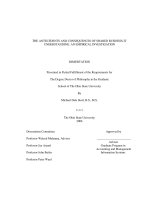
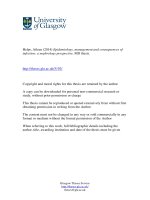
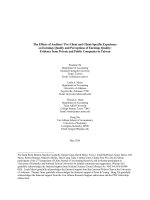
![[cg-fiq] fathi - 2013 - corporate governance system and quality of financial information in french](https://media.store123doc.com/images/document/2015_01/06/medium_vaa1420548471.jpg)
